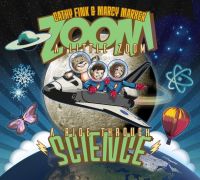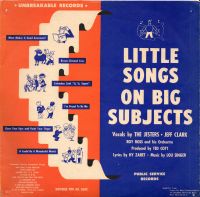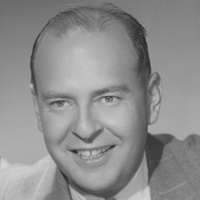






You don't hear so much about Brother Jonathan these days, but when I was a youngster I heard many a tale about the singing fiddler who travelled up and down the countryside, spreading his songs like seed across the mountains and valleys of America. And I've heard them say, "when Brother Jonathan played the fiddle the sun came out and the flowers danced in the fields;" and people who heard him play of an evening would stand around listening with a look of wonderment in their eyes, as if they had seen a miracle.
For Brother Jonathan sang of America - what it means and what it can be. His eyes saw the dream of freedom shining down like stars upon a beautiful land and he lifted his voice and put the dream into song. But he knew the world is made up of little people so his songs had simple words and the smile in them was a greeting to his friends. And the people understood Brother Jonathan, the singing fiddler, and his little songs became a part of them.
In 1946, Ted Cott, as program director for radio station WNEW, commissioned Hy Zaret and Lou Singer to write a series of one minute "jingles" on racial understanding and Americanism that would play on radio as public service "spot" announcements (later known as Public Service Announcements (PSAs)). The resulting collection of songs was called Little Songs on Big Subjects. In 1947, Cott produced recordings with Jeff Clark, The Jesters, and the Roy Ross Orchestra. On 21 May 1947, WNEW starting airing 5 of the songs: "Brown-Skinned Cow", "Close Your Eyes and Point Your Finger" (2 minute and 1 minute versions), "I'm Proud To Be Me", "What Makes a Good American", and "Columbus Said 'Si, Si, Signor'". The Institute for Democratic Education (funded by the Anti Defamation League of B'nai B'rith) produced a record to distribute the songs to stations throughout the U.S., and the songs aired daily on hundreds of radio stations. On 11 February 1948 (Lincoln's Birthday), WNEW officially received an award from the National Conference of Christians and Jews (for contributing to "understanding and respect among the American people"), and started airing six more of the songs: "It Could Be a Wonderful World", "I've Got a Church - You've Got a Church", "Travelling Broadens One", "American Hymn", "Ol' Commodore Gray", and "There Were Thirteen Colonies". Public Service Records (a label of Argosy) produced a non-commercial record of the songs. By 1949, an executive from WNEW estimated the songs had aired half a million times on hundreds of radio stations.

_small.jpg)
In 1947, Argosy published a songbook with cover illustration by Roger Duvoisin, and VOX Records released an album (VOX VSP 306) in their Spotlight Series, with cover art by Don Shapiro and vocals by The Bachelors Listen. Ray Porter was the director and arranger. This album included all 12 songs.

In January 1949, Argosy issued an album with 11 of the original (1947) recordings featuring the Jesters Listen. It did not include "The Poor Old World." The cover design was by Otto Soglow.
Pete Seeger recorded "It Could be a Wonderful World" Listen. Teaching Tolerance used it in their programs. The Girl Scouts use "I'm Proud to be Me" and "I Want to Live in a Friendly World" in their Rock The Mall sing-along. In 1953, the Anti-Defamation League produced a musical cartoon of "Ol' Commodore Gray"; unfortunately, the video is no longer available.
Little Songs On Big Subjects received many accolades and awards.

In 1948, WNEW commissioned the team to write a second series of six songs called Little Songs About UN. These were recorded by The Jesters with Roy Ross and his orchestra. The United Nations radio station played them daily and shipped 1,000 copies to other radio stations. They were released as an album and a songbook in November 1949. This series also recieved many accolades and awards.
Over the next half decade, the team wrote Little Songs for Living Longer (1951) Listen. Little Songs on Fire Prevention (1956) Listen, Little Songs for Busy Voters (1956) Listen, Little Square Songs for Human Rights (1956), Little Songs for Polio Protection (1957) Listen, Sing-Along for Mental Health (1958) - which received the National Association for Mental Health Award for "outstanding contribution in the field of Mental Health" Listen, Little Songs for Better Schools (1958), and Little Songs for the ACS (1959) Listen.


Around 1953, Columbia Records commissioned the team to write a collection of songs about science: Now We Know (Songs to Learn By), sung by Tom Glazer and Paul Tripp (Mr. I Magination). They were distributed as an LP and as a set of 6 45 RPM records Listen. A few years after that, Basic Books commissioned the team to write an album for their Science Materials Center. The album was called Space Songs. It was such a success, the team used songs from Now We Know and wrote new songs for 5 more albums to create a six LP set called Ballads for the Age of Science.

In 1966, the team created another LP set called Spotlight Ballads to Light Up The World. The new series was about social studies. Unfortunately, many of the songs are dated, so revising them will be difficult. But the cover illustrations by Leo Lionni are, of course, wonderful. Please take time to admire them. In particular, note how they were designed for the circular wire racks used to display records (similar to racks still used to display wall calendars).

In 1967, to celebrate the 20th anniversary of the original Little Songs, Argosy produced an album called It Could be a Wonderful World, using new recordings of songs from Little Songs on Big Subjects and Little Songs About UN. Leon Bibb and Ronnie Gilbert are the lead singers, and Robert De Cormier is the conductor. The wonderful cover for the album was designed by Leo Lionni

In 2018, Argosy and Community Music released a new CD called Zoom a Little Zoom, featuring the GRAMMY award winning duo Cathy Fink & Marcy Marxer with new arrangments of 10 songs from Ballads for the Age of Science.